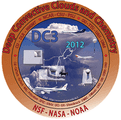The Multifunction Phased Array Radar (MPAR) is an airborne S-band radar designed for weather and aircraft surveillance. MPAR features a stationary, non-rotating panel, enabling faster scans than traditional weather radars. It operates in four scan modes simultaneously: Aircraft Track While Scan, Rapid Update Weather Scan, High Fidelity Horizon Weather Scan, and High Fidelity 3D Volume Weather Scan. It functions within the 2.7 to 2.9 GHz frequency range and has a beam width of 1.2 to 2 degrees.

Instrument Details
- Radar
- Earth Science > Spectral/engineering > Radar > Radial Velocity > Mean Radial VelocityEarth Science > Spectral/engineering > Radar > Radar ImageryEarth Science > Spectral/engineering > Radar > Return PowerEarth Science > Spectral/engineering > Radar > Radial VelocityEarth Science > Spectral/engineering > Radar > Radar Reflectivity
- Full Column Profile
- Variable
- N/A
- 2.7–2.9 GHz
- https://doi.org/10.1109/RADAR.2010.5494483
Currently unavailable
Currently unavailable
Currently unavailable
FAA
Currently unavailable
Unpublished
 Permanent Land Site Stationary 62 Campaigns · 101 Instruments |  Deep Convective Clouds & Chemistry 2012 Northeastern Colorado, West Texas to Central Oklahoma, Northern Alabama 1 Deployment · 19 Data Products
|